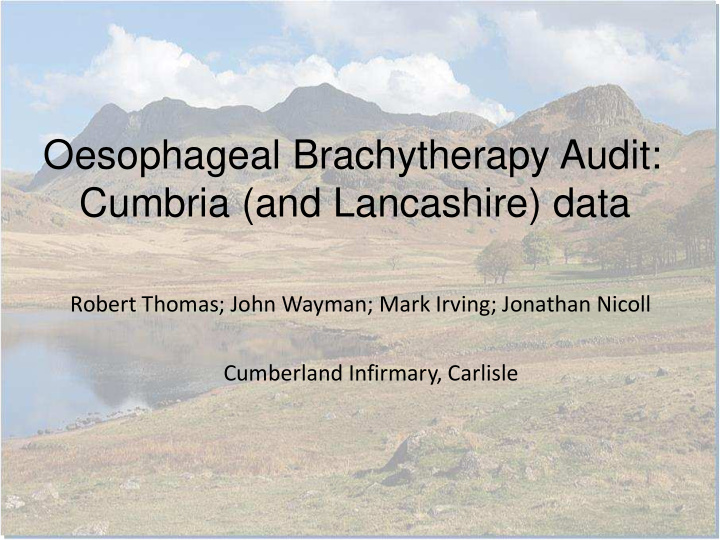



Oesophageal Brachytherapy Audit: Cumbria (and Lancashire) data Robert Thomas; John Wayman; Mark Irving; Jonathan Nicoll Cumberland Infirmary, Carlisle
Background MicroSelectron (later gammamed) established at CIC by Paul Dyson and Jonathan Nicoll in 1990s. Safe, effective, evidence-based treatment which can be delivered as day-case at very short notice. ( Shenfine, et al; Am J Gastroenterol, 2009 Jul; 104(7):1674-85) Remains an important treatment option for patients with incurable oesphago-gastric cancer. Brachytherapy available in only 54% of Cancer Networks responding to survey. Reported in the National Oesophago- Gastric Cancer Audit 2012.
Background (National OGC audit 2012) • The uptake of brachytherapy is still relatively low. • Brachytherapy can be used to treat dysphagia with few adverse effects, and should be considered if life expectancy is more than 3 months. • Fewer trusts reported using brachytherapy • After stent insertion 57 per cent of patients survived more than 3 months. These patients may have been suitable for brachytherapy instead, as it may provide better symptom relief with fewer complications in patients with a longer prognosis [Homs et al 2004]. • Currently brachytherapy is not widely available in the UK, with only 54 per cent Cancer Networks reporting access to it compared to 100 per cent for stenting in the last NOGCA organisational survey 2012. • Need for data to be kept up-to-date locally
Methods • Patient selection – Palliative radiotherapy for oesophageal SCC, adenoCa or adenoCa of OG junction. Single fraction therapy given after completion of 30Gy EBRT or two fractions 6 weeks apart. – MDM based
Methods • Patient endoscoped under sedation and upper and lower tumour limits identified. Guidewire passed and micro-selectron tube introduced. • Wire advanced into delivery tube for calibration and patient transferred to radiotherapy unit • Tube attached to delivery unit and iridium introduced on wire . All instruments removed and patient discharged same day.
Results • Demographics – 2012/2013 – 32 patients (14 single treatment, 12 two and 6 three) 56 treatments – Male 12 (38%) – Median age 79 (64-93) – Oesophagus tumour site in 29 (90%), GOJ 3 – Adenocarcinoma in 21 (66%)
Results • Pre-brachytherapy treatment – Surgery 0 – External beam 5 – Chemotherapy 7 • Post-brachytherapy treatment – Stent 9 – Dilatation 2 – APC 1 – Laser 1 – Chemotherapy 2
Results • Follow up and complications – Complications 0 – Mortality 0 • Survival – Median survival time (from last treatment to death) 117 days (23-327) – Median survival similar for those having one treatment in comparison to >1 – Data incomplete in 8 patients
Survival for 1, 2 and 3 treatments K-M survival probability Last treatment to death (months)
Time to stenting from last treatment probability K-M Last treatment to stenting (months)
Conclusions • Brachytherapy relatively simple and safe • Survival suggests appropriate use in those with a better prognosis • No data on effect on symptoms, QoL etc
Thank you
Recommend
More recommend